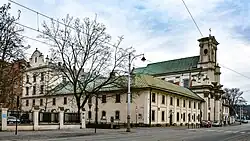Church of the Holy Trinity, Kraków (Kazimierz)
| Church of the Holy Trinity | |
|---|---|
Kościół Świętej Trójcy | |
 From right to left, church, monastery and old hospital of the Brothers Hospitallers of Saint John of God. View from Krakowska Street. | |
| 50°02′49.5″N 19°56′39″E / 50.047083°N 19.94417°E | |
| Location | Kraków |
| Address | 48 Krakowska Street |
| Country | Poland |
| Denomination | Roman Catholic |
| Type | Cultural |
| Criteria | iv |
| Designated | 1978 |
| Part of | Historic Centre of Kraków |
| Reference no. | 29 |
| Region | Europe and North America |
| Designated | 1994-09-08 |
| Part of | Kazimierz |
| Reference no. | M.P. 1994 nr 50 poz. 418[1] |
The Church of the Holy Trinity (Polish: Kościół Świętej Trójcy), known colloquially as the Brothers Hospitallers of Saint John of God Church (Polish: Kościół bonifratrów) is a historic Roman Catholic conventual and hospital church of the Brothers Hospitallers of Saint John of God located at 48 Krakowska Street in Kazimierz, the former district of Kraków, Poland. [2]
History
The church, monastery and hospital was built for the Order of the Most Holy Trinity and of the Captives (Trinitarians) between 1741 and 1758, designed by Francesco Placidi. The church was consecrated in 1758 by Bishop Franciszek Potkański, suffragan of Kraków. In 1796 the last monk died, the order was abolished and the buildings were taken over by the Austrian army as warehouses.
In 1812, Frederick Augustus I of Saxony, Duke of Warsaw, handed over the complex to the Order of Brothers Hospitallers.
In 3 Trynitarska Street, the Brothers Hospitallers built a new hospital in 1897 and 1906, designed by Teodor Talowski.
After World War II, the hospital was taken over by the state. In 1996, the buildings were returned to the order.[3][4]
Architecture
The Baroque façade designed by Francesco Placidi. Church has a one nave and late Baroque interior. In the main altar there is a sculpture of Jesus of Nazareth, consecrated in 1759 by Pope Clement XIII and given to the Trinitarians.
Illusionistic decorations and fresco are the work of artist from Moravia - Joseph Piltz.[5][6]
Footnotes
- ^ Zarządzenie Prezydenta Rzeczypospolitej Polskiej z dnia 8 września 1994 r. w sprawie uznania za pomnik historii., M.P., 1994, vol. 50, No. 418
- ^ Michał Rożek, Barbara Gądkowa Leksykon kościołów Krakowa, Wydawnictwo Verso, Kraków 2003, pp. 177-178
- ^ Praca zbiorowa Encyklopedia Krakowa, wydawca Biblioteka Kraków i Muzeum Krakowa, Kraków 2023, ISBN 978-83-66253-46-9 volume I page 758
- ^ Michał Rożek, Barbara Gądkowa Leksykon kościołów Krakowa, Wydawnictwo Verso, Kraków 2003, pp 177-178
- ^ Praca zbiorowa Encyklopedia Krakowa, wydawca Biblioteka Kraków i Muzeum Krakowa, Kraków 2023, volume I page 758
- ^ Michał Rożek, Barbara Gądkowa Leksykon kościołów Krakowa, Wydawnictwo Verso, Kraków 2003, pp 177-178
Bibliography
- (in Polish) * Michał Rożek, Barbara Gądkowa Leksykon kościołów Krakowa, Wydawnictwo Verso, Kraków 2003, ISBN 83-919281-0-1 pp. 177-178 (Lexicon of Krakow churches)
- (in Polish) * Praca zbiorowa Encyklopedia Krakowa, wydawca Biblioteka Kraków i Muzeum Krakowa, Kraków 2023, ISBN 978-83-66253-46-9 volume I page 758 (Encyclopedia of Krakow)